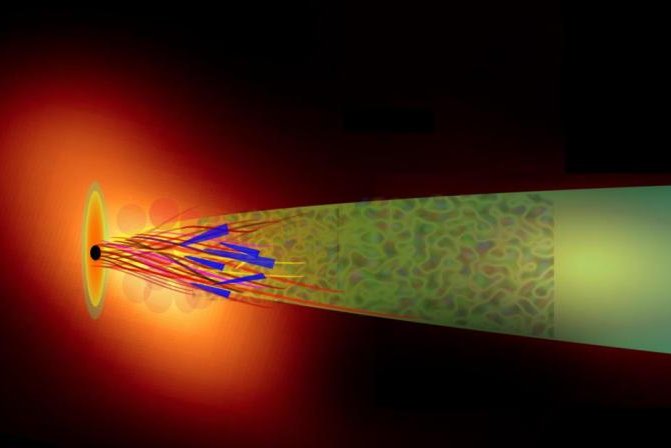New research suggests a phenomenon called magnetic reconnection is responsible for the flickering gamma radiation emitted by the quasar 3C279. Photo by Amit Shukla/Indian Institute of Technology Indore
Aug. 21 (UPI) -- Astronomers have discovered a powerful plasma jet that mysteriously lights up far from its origins. The discovery, detailed Friday in the journal Nature Communications, suggests that such flares are powered by what is called magnetic reconnection.
Black holes can pull in and destroy matter, gas and light from tremendous distances. As this ill-fated matter condenses and swirls violently toward a black hole, the turbulence generates powerful plasma beams than can extend for thousands of light-years.
The bending of light in the center of a black hole creates what is called a black hole's shadow, causing the jets to seemingly appear out of nowhere. Recently, astronomers observed plasma jets emerging especially far from their black hole source.
Observations captured by the Event Horizon Telescope showed the jets from quasar 3C279 suddenly light up at a distance thousand times greater than the shadow of the black hole.
Followup observations from the NASA space telescope Fermi-LAT determined the jets not only yield emissions in the millimeter wavelength range, but also produces high-energy gamma radiation. Measurements of the high-energy gamma radiation revealed a dramatic flickering effect.
Analysis of the flickering pattern proved the sequencing is emblematic of a universal process called magnetic reconnection -- a phenomena commonly observed in astrophysical objects with powerful magnetic fields.
"I saw how the analysis of the data revealed the special pattern of magnetic reconnection in the light curve," astrophysicist Amit Shukla, who led the research while at the University of Würzburg, JHU, in Germany, but now works Indian Institute of Technology, said in a news release.
"It felt as if I had suddenly deciphered a hieroglyph in the black hole alphabet."
Scientists previously were puzzled by how the jet's energy appeared to travel through an invisible chimney before igniting brightly far from the black hole. But Shukla's discovery suggests the jet's energy is stored invisibly in the magnetic field.
During the magnetic reconnection process, this invisible energy is released in the form of several miniature jets, each filled with accelerating particles. These jets combine to produce powerful gamma radiation.
"Spacetime near the black hole in the quasar 3C279 is forced to swirl around in corotation," said study co-author Karl Mannheim, chair of the astronomy astronomy at JHU.
"Magnetic fields anchored to the plasma around the black hole expel the jet slowing down the black hole's rotation and converting part of its rotational energy into radiation."















